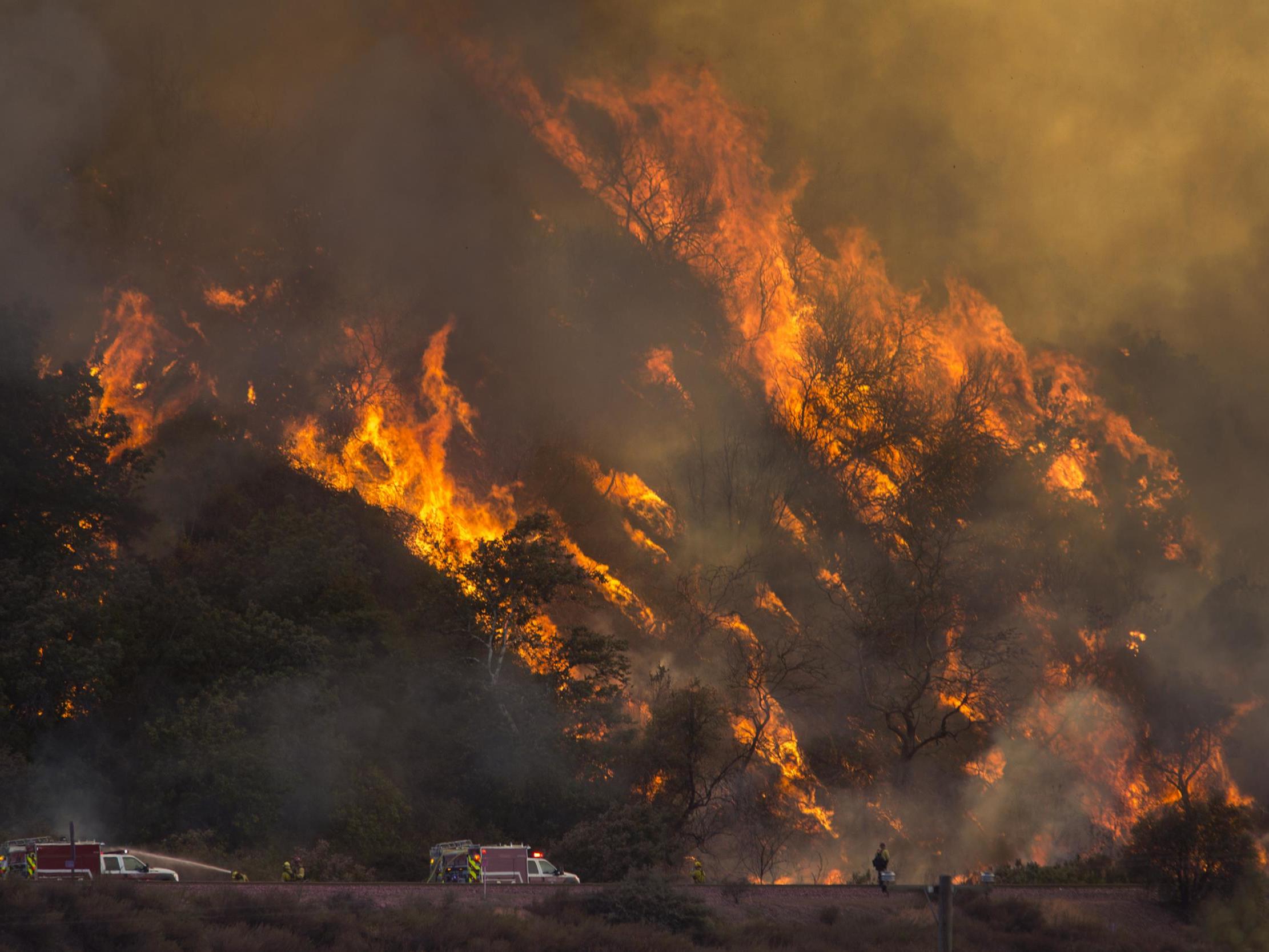California wildfires: Death toll rises as thousands of residents urged to evacuate
A state of disaster has been declared in California
A 70-year-old man died in California on Sunday as huge wildfires continued to tear through the state.
Authorities said the victim was discovered near Last Chance Road, Santa Cruz County as the CZU Complex Fire caused widespread damage in the area.
The fatality was the first for the fire in CZU – the California fire department's designation for the area that spans San Mateo, Santa Cruz and San Francisco counties – and the seventh fire victim in the state in total.
The Santa Cruz fire is one of the “complexes”, or groups of fires, burning on all sides of the San Francisco Bay Area. They were started by lightning strikes that were among 12,000 registered in the state in the past week.
Hundreds of thousands of residents were told to evacuate the San Francisco Bay Area over the weekend as president Donald Trump declared a major disaster in the state.
Firefighters tackling blazes in the Santa Cruz mountains said their efforts had been hampered by people refusing to leave their homes, with more storms and new fires expected in the coming days.
The area was under an evacuation order.
Santa Cruz Sheriff’s Department Chief Deputy Chris Clark said the death of the 70-year-old man was a stark reminder of the need for residents to leave the area as he called on people to evacuate.
“This is one of the darkest periods we’ve been in with this fire,” he said.
The National Weather Service has issued a “red flag” warning through Monday afternoon for the drought-stricken area, meaning extreme fire conditions including high temperatures, low humidity and wind gusts up to 65 mph (105 kph) that “may result in dangerous and unpredictable fire behaviour”.
In nearly a week, firefighters have got no more than the 17 per cent containment for the LNU Lightning Complex fire in wine country north of San Francisco.
It’s been the most destructive blaze, accounting for five deaths and 845 destroyed homes and other buildings. It and a fire burning southeast of the Bay Area are among the five largest fires in state history, with both burning more than 500 square miles (1,295 square kilometres).
In Southern California, an 11-day-old blaze held steady at just under 50 square miles (106 square kilometres) near Lake Hughes in northern Los Angeles County mountains. Rough terrain, hot weather and the potential for thunderstorms with lightning strikes challenged firefighters.
Holly Hansen was among evacuees from the community of Angwin being allowed to back their homes for one hour to retrieve belongings. She and her three dogs waited five hours in her SUV for their turn.
“It’s horrible, I lived in Sonoma during the (2017) Tubbs Fire, so this is time No 2 for me. It’s horrible when you have to think about what to take,” she said. “I think it’s a very raw human base emotion to have fear of fire and losing everything. It’s frightening.”
Meantime, firefighters were frantically preparing for thunderstorms that will bring high winds and “dry” lightning, a term used when such storms have little or no rain. Brunton said while he’s confident firefighters did the most with the time they had to prepare, he’s not sure what to expect.
“There’s a lot of potential for things to really go crazy out there,” he said.

Since 15 August more than 500 fires of varying sizes have burned throughout California, scorching 1.2 million acres, or 1,875 square miles (4,856 square km). Of those, about two dozen major fires were attracting much of the state’s resources.
The fires have burned 1,175 square miles (3.043 square km), destroyed almost 1,000 homes and other structures and now killed seven people, three of whom who were found in a home in an area under an evacuation order.
Other casualties included ancient redwood trees at California’s oldest state park, Big Basin Redwoods, plus the park’s headquarters and campgrounds. Smoke from the fires made the region’s air quality dangerous, forcing millions to stay inside.
Officials surveying maps at command centres are astonished by the sheer size of the fires, Cal Fire spokesman Brice Bennett said.
“You could overlay half of one of these fires and it covers the entire city of San Francisco,” Bennett said on Sunday.
Responding to the emergency, president Donald Trump on Saturday issued a major disaster declaration to provide federal assistance. California Governor Gavin Newsom said in a statement that the declaration will also help people in counties affected by the fires with crisis counselling, housing and other social services.
Fire officials, meanwhile, have struggled to get enough resources to fight the biggest fires because so many blazes are burning around the state.
The wine country fire has only 1,700 firefighters on scene. By comparison, the state had 5,000 firefighters assigned to the Mendocino Complex Fire in 2018, the largest fire in state history.
“All of our resources remain stretched to capacity that we have not seen in recent history,” said Shana Jones, the chief for Cal Fire’s Sonoma-Lake-Napa unit.
Additional reporting by agencies
Join our commenting forum
Join thought-provoking conversations, follow other Independent readers and see their replies
Comments
Bookmark popover
Removed from bookmarks